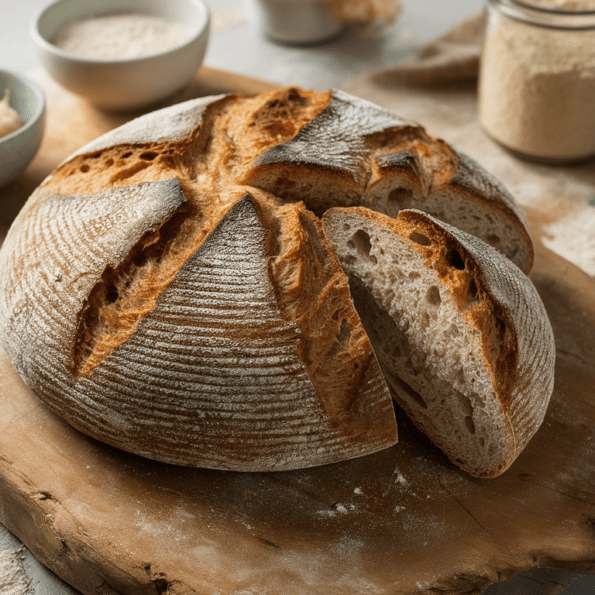
Pugliese Bread Recipe

Today, we're journeying to the sun-drenched fields of Puglia, Italy, to bring you the rustic charm of our Pugliese bread recipe. This traditional loaf, with its irresistibly crispy crust and airy, moist interior, is a testament to the region's rich agricultural heritage. Perfect for sandwiches, dipping, or simply enjoying with a slather of butter, this bread is sure to become a staple in your kitchen.
History of Pugliese Bread:
Did you know that Pugliese bread has its roots in the "breadbasket" of Italy, the Puglia region? This area is renowned for its durum wheat, which gives the bread its distinctive yellow hue and hearty texture. The inclusion of mashed potatoes is a unique twist, contributing to the bread's softness and moisture. Traditionally, this bread was baked in communal ovens, where families would gather, sharing not just the ovens but also stories and laughter.
Serving Suggestions for Pugliese Bread:
This versatile bread pairs wonderfully with a variety of dishes. Enjoy it as a base for bruschetta topped with fresh tomatoes, basil, and olive oil. It's also perfect for accompanying hearty soups and stews, soaking up every last bit of delicious broth. For a simple yet delightful snack, toast slices and spread with a rich tapenade or creamy ricotta.
Storing Instructions for Pugliese Bread:
To keep your Pugliese bread fresh, store it in a paper bag at room temperature for up to two days. For longer storage, wrap it tightly in aluminium foil and place it in a plastic bag before freezing. The bread can be frozen for up to three months.
Reheating Instructions for Pugliese Bread:
To enjoy your bread as if it were freshly baked, preheat your oven to 180°C (350°F). Place the bread directly on the oven rack or on a baking sheet and heat for 10-15 minutes. This will help revive the crust’s crispiness and the interior's softness. Avoid microwaving, as it can make the bread tough and chewy.
Conclusion:
We'd love to hear how your Pugliese bread turned out! Share your baking adventures in the comments below and let us know your favourite ways to enjoy this delicious loaf. Don't forget to subscribe to our newsletter for more traditional recipes and culinary tips straight from the heart of Ireland and beyond.
How to Make Pugliese Bread Recipe
Experience the authentic taste of Italy with this Pugliese bread recipe. Featuring a crispy crust and a tender, airy crumb, this rustic loaf is perfect for sandwiches, dipping, or enjoying with a simple spread. Made with a mix of strong white bread flour, durum semolina, and a touch of mashed potatoes, this bread brings the traditional flavours of Puglia right to your kitchen.
- 300 g strong white bread flour
- 180 ml water (room temperature)
- 1/4 tsp active dry yeast
- 300 g biga (prepared the day before)
- 200 g strong white bread flour
- 200 g fine durum semolina
- 250 ml lukewarm water
- 10 g salt
- 5 g active dry yeast
- 100 g mashed potatoes (about 1 small potato, cooked and mashed)
- Dissolve Yeast
In a large bowl, dissolve 1/4 tsp active dry yeast in 180 ml of room temperature water.
- Add Flour
Add 300 g of strong white bread flour and mix until a dough forms.
- Cover and Ferment
Cover the bowl with plastic wrap and let it sit at room temperature for 12-16 hours. The biga should triple in volume and become bubbly.
- Mix Ingredients
In a large mixing bowl, combine 300 g of prepared biga, 200 g of strong white bread flour, 200 g of fine durum semolina, 5 g of active dry yeast, and 100 g of mashed potatoes.
- Add Water
Gradually add 250 ml of lukewarm water while mixing until a sticky dough forms.
- Rest the Dough
Cover the bowl with a damp cloth and let the dough rest for 30 minutes to allow the flour to fully absorb the water.
- Knead Dough
Knead the dough on a lightly floured surface or in a stand mixer with a dough hook for about 10 minutes until smooth and elastic.
- First Rise
Let Dough Rise: Place the dough in a lightly oiled bowl, cover with plastic wrap, and let it rise at room temperature for about 1 hour or until doubled in size.
- Shape
Shape Dough: Turn the dough out onto a lightly floured surface and shape it into a round loaf. Place it in a floured banneton or a bowl lined with a floured cloth.
- Second Rise
Final Rise: Cover and let it rise for another 1-1.5 hours until it has nearly doubled in size.
- Heat OvenPreheat your oven to 240°C (465°F) with a baking stone or a Dutch oven inside.
- Bake Loaf
If using a baking stone, transfer the loaf onto the stone and reduce the oven temperature to 220°C (430°F). If using a Dutch oven, carefully place the dough into the preheated pot, cover with the lid, and bake for 20 minutes.
- Finish Baking
Remove the lid and bake for an additional 25-30 minutes until the crust is golden brown and the loaf sounds hollow when tapped.
- Cool Bread
Transfer the bread to a wire rack and let it cool completely before slicing.
- Slice and Serve
Once the bread has cooled completely, slice it with a serrated knife.
- Enjoy
Serve the Pugliese bread as a base for bruschetta, alongside soups, or simply with butter and jam.
- Amount Per Serving
- Calories 220kcal
- Calories from Fat 9kcal
- % Daily Value *
- Total Fat 1g2%
- Sodium 200mg9%
- Potassium 75mg3%
- Total Carbohydrate 45g15%
- Dietary Fiber 2g8%
- Protein 7g15%
- Calcium 15 mg
- Iron 2 mg
* Percent Daily Values are based on a 2,000 calorie diet. Your daily value may be higher or lower depending on your calorie needs.
- Biga Preparation: Ensure the biga is prepared 12-16 hours in advance for best results.
- Mashed Potatoes: Use freshly mashed potatoes for the best texture and flavour.
- Flour Surface Lightly: When working with the dough, use just enough flour to prevent sticking without making the dough too dry.
- Oven Temperature: The initial high temperature helps create a crispy crust, so preheat the oven well in advance.
- Cooling Time: Allow the bread to cool completely before slicing to ensure the crumb sets properly.
- Storage: Store in a paper bag to keep the crust crisp; for longer storage, freeze in airtight wrapping.



